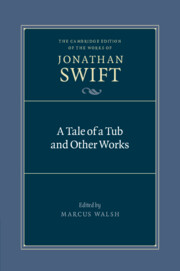Book contents
- Frontmatter
- Contents
- List of Illustrations
- General Editors’ Preface
- Acknowledgements
- Chronology
- List of Abbreviations
- Introduction
- A Tale of a Tub
- The Battel of the Books
- A Discourse Concerning the Mechanical Operation of the Spirit
- Swift’s Editorial Matter for Temple’s Posthumous Publications
- Appendices
- Textual Introduction
- Explanatory Notes
- Bibliography
- Index
Textual Introduction
Published online by Cambridge University Press: 02 September 2021
- Frontmatter
- Contents
- List of Illustrations
- General Editors’ Preface
- Acknowledgements
- Chronology
- List of Abbreviations
- Introduction
- A Tale of a Tub
- The Battel of the Books
- A Discourse Concerning the Mechanical Operation of the Spirit
- Swift’s Editorial Matter for Temple’s Posthumous Publications
- Appendices
- Textual Introduction
- Explanatory Notes
- Bibliography
- Index
Summary
Textual policy
The first five editions of A Tale of a Tub and the choice of a copy text
A Tale of a Tub, and its associated works, went through three editions in 1704, a fourth in 1705, and a fifth, ‘with the Author's Apology and Explanatory Notes. By W. W—tt—n, B. D. and others’, in late 1710. Of these, only editions 1 and 5 have independent authority. The second, third and fourth editions are successive reprints of edition 1, and introduce new errors as well as some corrections. The fifth edition reprints, from the fourth edition, the textus receptus of the Tale, the Battel, and the Mechanical Operation of the Spirit, embodying errors accumulated in the process of transmission from the first edition, some new errors and some corrections, as well as a small number of clearly authorial changes. The inclusion of the Apology, however, the addition of the footnotes, the plates and the attention given to it by Swift, as evidenced by the letters between himself and Tooke, make this the concrete representation of a new version, taking ‘version’ to mean the form (to use Peter Shillingsburg's definition) ‘of a work as it was intended at a single moment or period for the author’. Though further editions appeared in Swift's lifetime, there is no evidence of significant authorial revision or involvement in any of them.
It has been argued recently that the changes of 1710 are alien to Swift's original intention, produced in response to external pressures, and in particular that the Apology is a foreign body. Frank H. Ellis, in the strongest statement of this argument, asserts that the fifth edition is not a separate work (and cannot therefore be edited as if it were a separate work), but ‘simply A Tale of a Tub (1704) illustrated, annotated, and bowdlerized, with “An Apology” tacked on’. Ellis argues that the Apology should not be considered part of the original creative act of the Tale, since the Swift who wrote it in 1709 was not the Swift who had first composed the Tale back in 1696–7. The Apology was written at a time when he was no longer ‘a boily boy, a je m’en foutiste’, but an ambitious and now middle-aged clergyman concerned to protect and advance his church career.
- Type
- Chapter
- Information
- A Tale of a Tub and Other Works , pp. 275 - 314Publisher: Cambridge University PressPrint publication year: 2010

